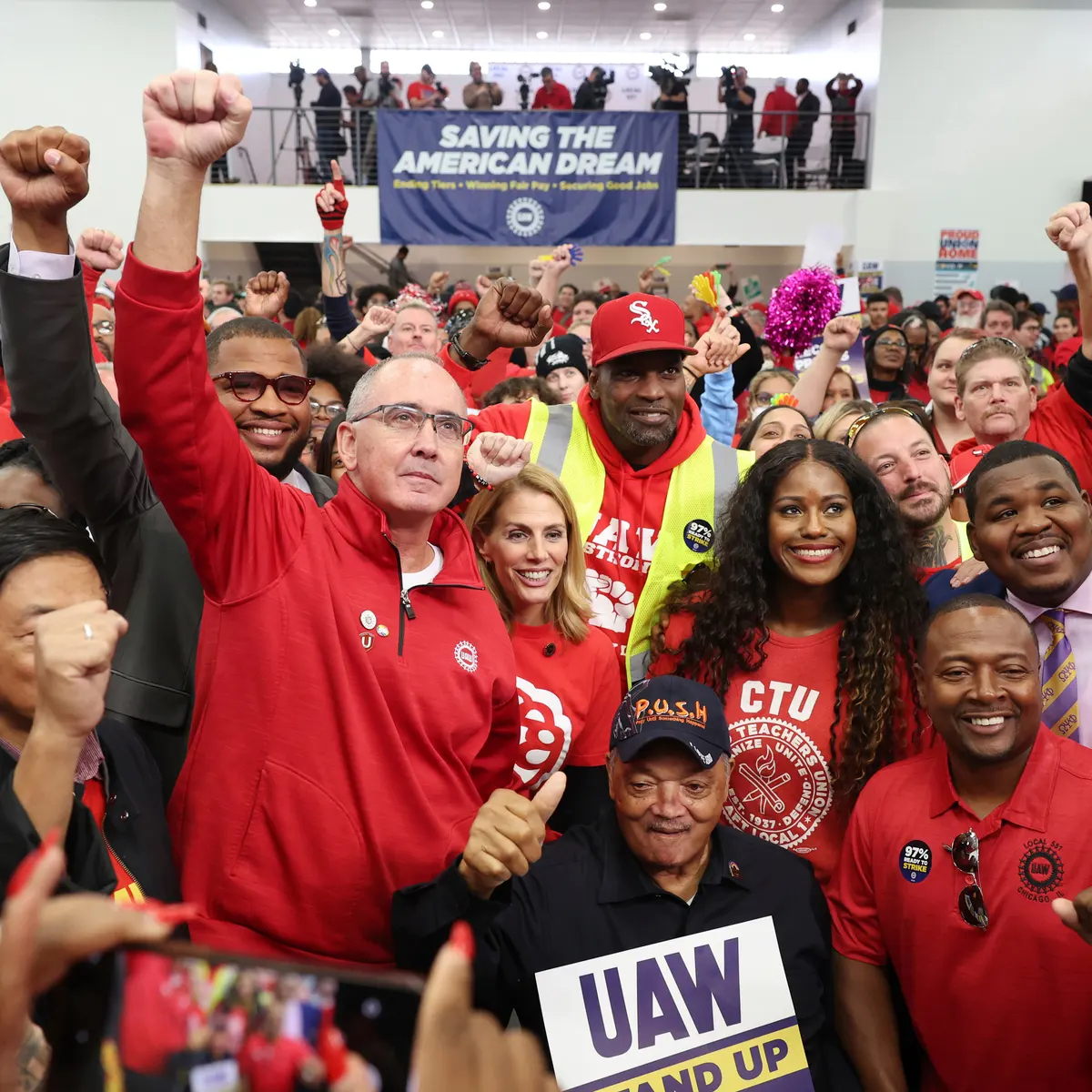After forty-one days of strike action, the UAW (United Automobile Workers) union has achieved a historic victory over the big three automakers Ford, General Motors and Stellantis (Chrysler). This victory puts an end to 43 years of concessions and defeats that began in 1979, when the UAW agreed to suspend all agreements signed with Chrysler’s then-bankrupt management. During this long period, nearly 60 production sites were closed or relocated to Mexico, and the union had continually accepted, albeit reluctantly, wage moderation and productive flexibility in addition to a category of workers performing the same operations, but paid $10 or $15/hour less called ‘second tier’ (second segment). At the same time, the automotive sector has undergone a profound transformation and is enjoying a resurgence of activity. Employing 1.2 million workers today, compared with 850,000 in 1980, automakers have diversified with the arrival of German (VW, Mercedes) and Japanese (Toyota, Nissan, Honda) brands and, more recently, the accelerated development of electric vehicle production sites.
The advances achieved by the UAW are historic in several respects. In addition to a 25% increase over four years (the duration of the collective agreement), and the integration of temporary workers into the permanent category (CDI), it is above all the abolition of the dual system with second-tier workers that represents a victory over precariousness and overexploitation, since these workers will benefit from an increase of up to 150% of the hourly wage in certain cases. The union also won the restoration of cost-of-living adjustment (COLA), which had been abolished in 2008. Applied to all Big Three unionized workers, the restoration of indexation should add 8% to the wage increases obtained elsewhere. Temporary staff with more than 90 days’ seniority will be immediately converted to permanent status. Future temps will become permanent workers after nine months, which will count towards their progression to the top rate of the pay grid. The only downside to this victory lies in the area of pensions: although Ford has agreed to reinject resources into the pension funds, this is still insufficient to guarantee the same pension rights to all categories of workers.
How was such a victory possible?
A change in union leadership played a key role in this victory. The UAW’s new president, Shawn Fain, was elected after a hard-fought battle by a radical caucus United All Workers for Democracy, which has been formed a decade ago. Two years ago, this caucus had won the election of the president by direct suffrage, but narrowly failed to win the internal vote. Over the following year, the UAW union leadership was rocked by a series of corruption and personal enrichment scandals. During this turbulent period, Shawn Fain gained recognition as a grassroots unionist opposed to concessions and pay inequality. In the spring of 2023, Fain led an internal campaign around the slogan ‘No corruption, No concessions, No tier’, winning the internal election against Ray Curry, who represented a more moderate orientation towards the Big 3.
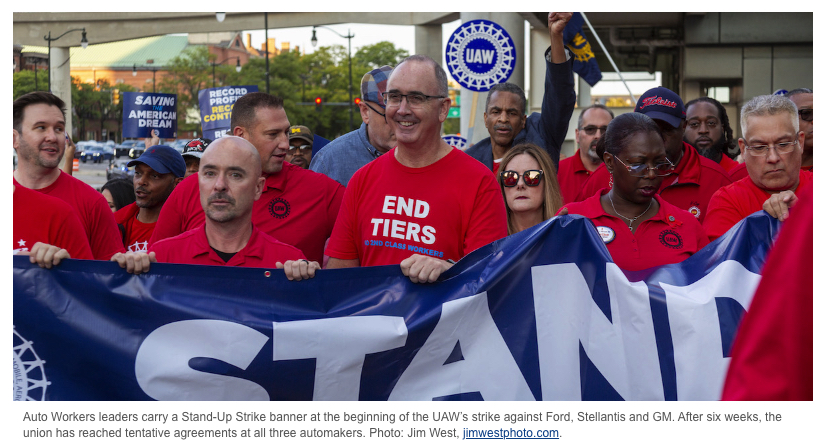
Shawn Fain has appeared on several occasions with Bernie Sanders and led a media campaign since his election, announcing the return of a unionism capable of bringing about social progress. By articulating a discourse centered on social justice with a critique of class contempt towards those who work, Shawn Fain embodied a desire among members to obtain good wages and regain a social condition assimilated to the middle class. It‘s also true that in adopting the Green New Deal, the government under President Joe Biden had been very generous to manufacturers. Subsidies and interest-free loans to finance the ecological transition amounted to considerable sums, on the order of $25-30 billion per manufacturer. The UAW’s new leadership sensed that the time for offensive action had finally arrived.
Shortly after his election, Shawn Fain mobilized members by announcing the return of combat unionism, unafraid to engage in conflict with the firm conviction that he could win. By announcing a calendar of stand-up strikes, Fain mobilized the powerful memorial symbol of the sit-down strikes of 1936-1937, which had enabled the UAW to gain union recognition. [1].
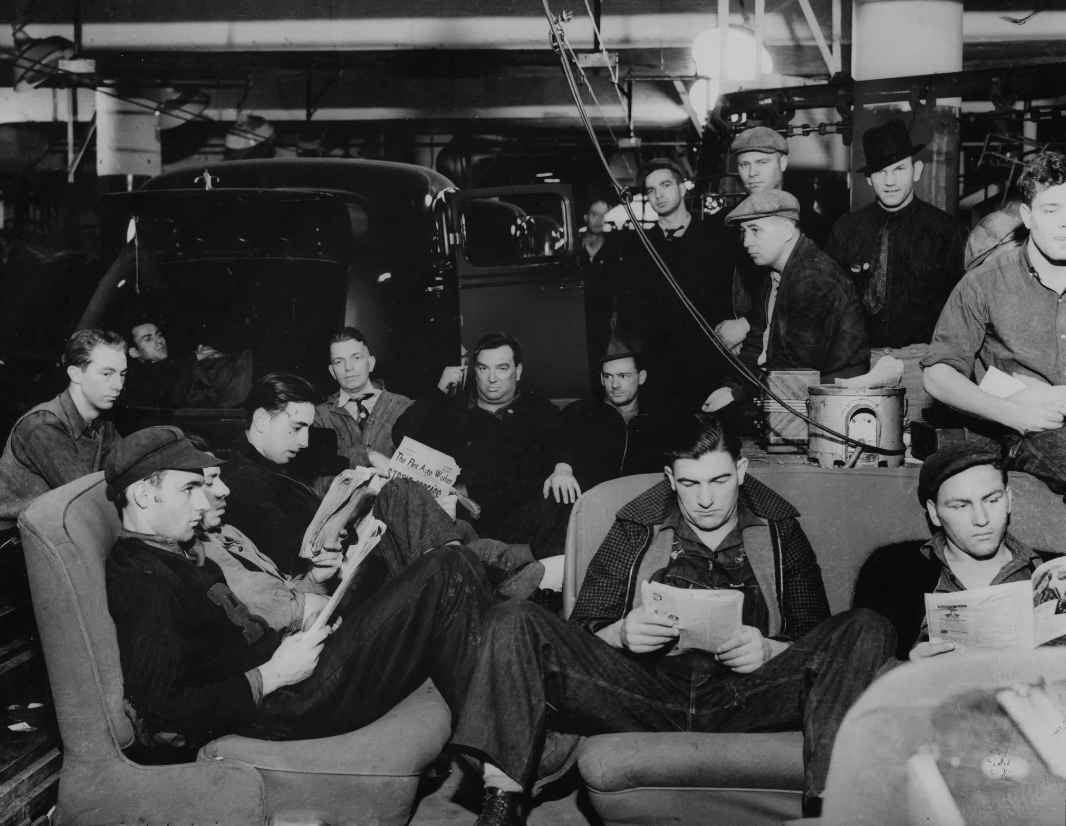
The stand-up strike campaign targeted all three manufacturers simultaneously, a departure from the previous period. Previously, the tried-and-tested tactic had been to target a single manufacturer and then extend wage gains to the other two. But this mode of action had become outdated, if not counter-productive. Indeed, any union concession on working hours or wages resulted in symmetrical setbacks at the other manufacturers. The relocation of assembly plants to southern states or Mexico, where there was no union representation, gave management a formidable weapon, which it did not hesitate to use to wrest concessions from the historic plants in the Great Lakes area (Detroit-Flint-Chicago-Cleveland). To break out of this spiral of social regression, the ‘Big Three’ had to be targeted simultaneously. This bold and, in some respects, risky choice required the firm guarantee of being fully capable of shutting down sites for an extended period. In early September, the UAW announced a schedule of forty staggered strike days, but without disclosing which sites would be shut down. In this way, the union gave itself the means to multiply the disruptive effect, disrupting supply and creating chaos in production schedules.
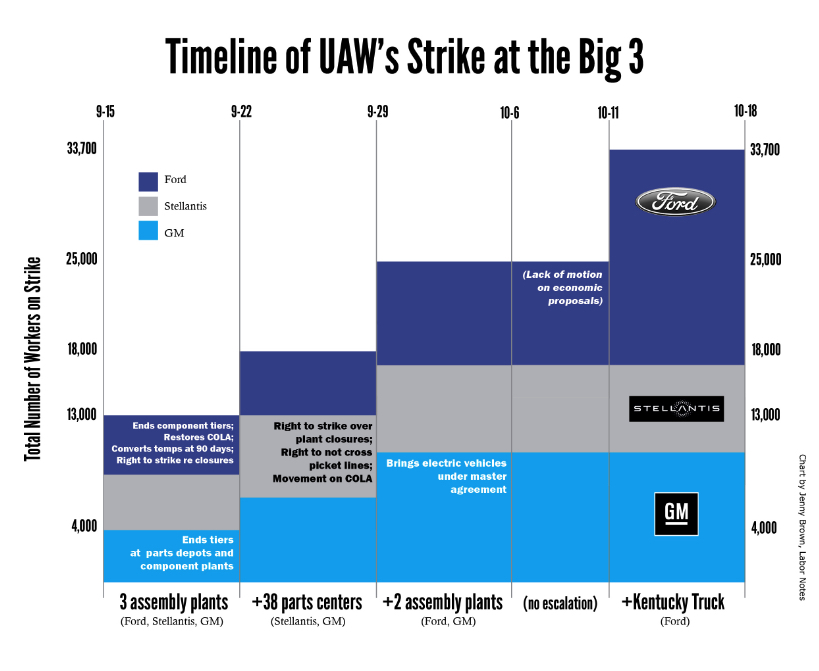
This strike tactic drew its strength from the surprise effect compared to a networked, just-in-time organization of the work process. Not knowing where the union would strike, the manufacturers had piled up stocks of engines and other essential components. But against all odds, the union chose to organize walkouts and strikes elsewhere than in assembly plants, bringing distribution centers to a standstill before targeting assembly units for high-end vehicles such as 4 x 4s or luxury models.
By alternating strikes in logistics centers, assembly plants and essential component manufacturing units, the UAW succeeded in maximizing the disruptive effects of work stoppages while sparing its strike fund. Every plant affected by a work stoppage was completely shut down, and every UAW member received $100 per day of strike pay…
At sites not affected by a work stoppage, workers were instructed to refuse overtime and to work in the strictest possible manner, respecting technical instructions and safety standards to the letter. At the beginning of October, the UAW announced that there were no concerns about continuing strike action until thanksgiving (November 23)… In mid-October, General Motors and Ford began to concede wage increases and the return of indexation. Chrysler-Stellantis still refused to follow suit, prompting the UAW to concentrate strike action at this manufacturer, making Carlos Tavares, whose annual salary is $26 million, the epitome of managerial venality.
Stop the descent into hell
When Ford and General Motors began to make concessions on one or other point in the list of demands, the UAW decided to push the envelope by stepping up the pressure on Chrysler-Stellantis, the most reluctant of the three. Caught between concessions from other manufacturers, where production was resuming, and strikes targeting the most profitable models, Stellantis finally agreed to reopen the former Jeep Cherokee plant, assigning it to the manufacture of electric batteries and the creation of 5,000 jobs, enabling the 1,500 laid-off workers to be rehired by the end of 2022.
This decision represents a real turning point in the American tradition of industrial relations. In 1946, the UAW had led a one hundred and thirteen-day strike at General Motors to obtain the right to ‘open the books’ and, above all, the right to veto any decision affecting the organization of production. For Walter Reuther, then head of the UAW and a socialist activist trained in the doctrine of workers’ control [2]the stakes were of strategic importance. Seeing the arrival of numerically controlled machine tools, Reuther was convinced that unionism limited to wage demands would sooner or later be overtaken by technological innovations. But for General Motors, it was out of the question to concede even a particle of its managerial power. After 113 days of strike action, management had conceded, in the interests of social peace, wage increases and collective guarantees (security, health insurance, retirement) never seen before. But this victory was also a defeat… Having been purged of communist militants during the McCarthy era, the UAW had retreated to the agreed perimeter of industrial relations, leaving management free rein in decisions concerning work organization and investments.
According to Daniel Bell, then an editor at Fortune magazine, the UAW had only won a Pyrrhic victory, and the mountain of dollars that financed labor peace served above all to mask the emasculation of counter-power unionism. While Bell’s reasoning is far from wrong, for nearly three decades, auto workers saw their standard of living rise steadily to the point of embodying the social figure of the middle-class worker. But this trend was reversed in the 1980s, when auto workers were paid less and less, and their middle-class status began to erode. Nevertheless, the UAW’s new management team succeeded in transforming the feeling of downgrading into a resource for mobilization, invoking the need for wage ‘redress’ while positioning itself as a protagonist in safeguarding the American dream. This approach is far from “anti-capitalist”, but for the hundreds of thousands of workers in the sector and the union, it had become urgent to break the interminable cycle of defeat and social setbacks. In other words, the ideological stakes are there, but will remain secondary to the material stakes and the need to build up again a strong union is capable to exert is collective power.
The unexpected comeback of workers control
In addition to the strictly economic aspects, there is another victory to be highlighted. The 43-day strike led to the agreement to reopen Stellantis’ Belvidere plant. This concession revives the best traditions of workers’ control. [3] For the first time in union history, we obtained the reopening of a plant without having to accept wage losses or sacrifice jobs elsewhere. Better still, we’ve secured the same wage levels, health insurance coverage and pensions as the thermal assembly plants, already covered by collective bargaining agreements.”
This interpretation is no exaggeration. For Barry Eidlin, professor of sociology of industrial relations at McGill University, the reopening of the Belvidere plant marks a turning point, as it is the first time that the union has obtained the reopening of a plant while influencing investment choices and the organization of the work process. Previously, the UAW had only succeeded in postponing a closure or maintaining activity by making major wage or statutory concessions.
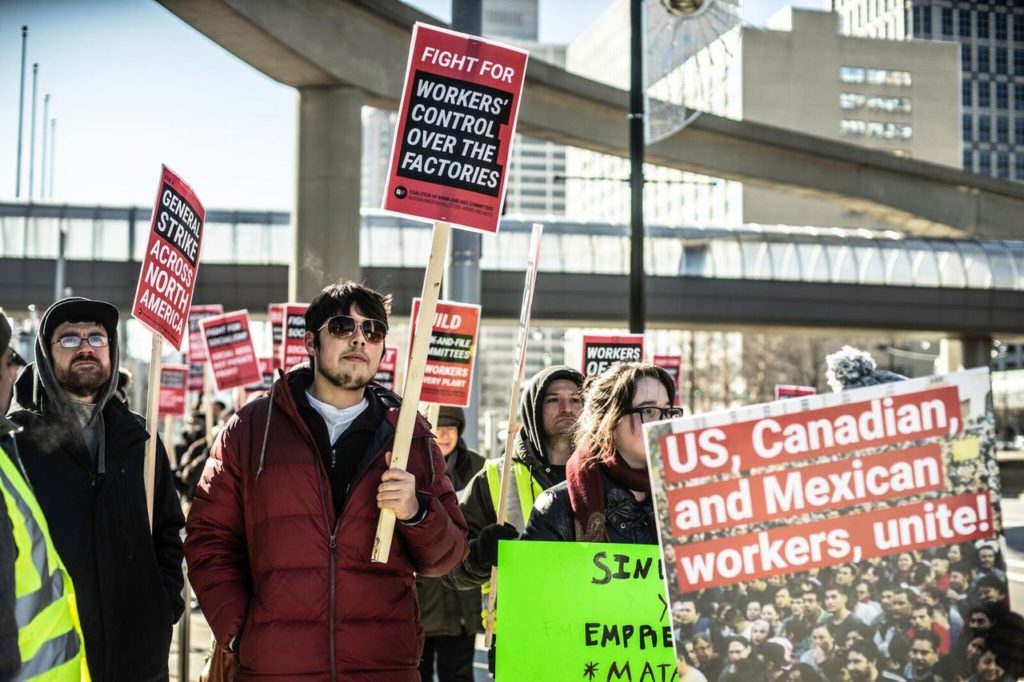
The doctrine of workers’ control is also behind a series of actions aimed at keeping electric vehicle production activities within the historic automotive perimeter. At the beginning of October, the UAW won the right for GM’s planned 6,000 electric vehicle job creations to be covered by the general framework agreement, rather than by a separate agreement with discounted wages. This victory also concerns semi-subsidiaries (joint-venture companies) such as Ultium Cells in Lordstown, Ohio, where the 1,300 workers will see their wages adjusted upwards from $16.50 to $28/hour, an advance that will be extended to seven other electric motor component manufacturing units.
General Motors in Spring Hill is another example of the topicality of worker control. At this Tennessee plant, GM decided to outsource painting and plastic molding to a company where wages start at $15 and end at $19 after four years. Although electric vehicles would have no impact on the paint and plastics activity, workers covered by automotive company agreements had suddenly been laid off. By obtaining the extension of wage scales and collective guarantees to companies manufacturing components, the UAW removes any advantage to outsourcing certain activities and avoids the fragmentation of work collectives along wage lines justified by technological pretexts. From now on, being assigned to certain specialized activities in the electric vehicle sector will no longer result in underpayment, which is no mean feat in a fast-growing market. Of the 14 million passenger cars sold each year in the United States, the share of electric vehicles is growing rapidly, reaching an annual volume of 800,000 units, representing 6% of the total, and almost doubling sales by 2021.
Climate and electoral issues
For the UAW, these multiple victories over the Big Three represent real war trophies which should enable it to force its way into the hands of manufacturers employing non-unionized workers. The equalization of wages in the electrical sector with those in the thermal sector is a victory that should make it easier to win over workers, who are still very skeptical about the ecological transition. For Shawn Fain, the ‘Green-Blue’ alliance is essential: “The climate crisis is not a fanciful rumor, and it’s essential that the ecological transition takes place while respecting the principles of social justice. We can’t accept green jobs being created by imposing low wages without collective guarantees.”
The stakes are of course high, including politically, since Donald Trump is opposed to the electrification of the car fleet “because these are low-paying jobs”. To counter Trump’s reactionary populism, the UAW has chosen not to throw itself into the arms of Democrat Joe Biden, but to demand guarantees on wages and union representation first. This tactic may seem very moderate, but it’s not without effect, since Joe Biden showed up at a picket line. Clearly, he will need the support of Midwestern autoworkers to win in these states, which have been hit by deindustrialization and the impoverishment of a working class that once believed itself to be middle-class…
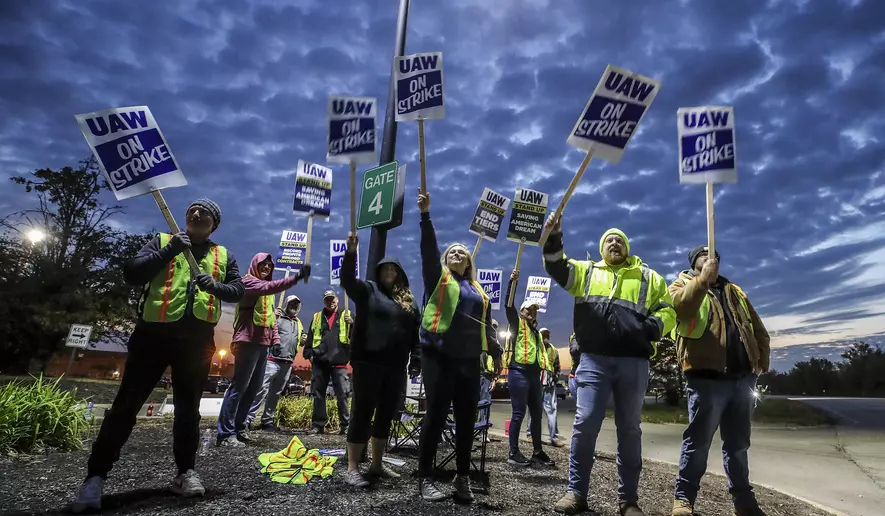
Given that Tesla’s factories are all union-free and without collective bargaining coverage, and that most foreign automakers are in the same situation, the union victory over the Big Three is undoubtedly also a concession inspired by a certain opportunism on the part of the big historic automakers: the market share of the Big 3 taken together achieved 42%, compared with 80% twenty years ago… For the US automakers, it is essential to preserve their market share, and to achieve this goal, they have every interest in reducing the competitive gap with their rivals. [4]. Having been forced to concede substantial wage increases and the end of the dualist system, it’s clear that the Big 3 are now making it easier for unions to enter competitors’ premises, to prevent the latter from exploiting their competitive advantages. It may be unusual, but fundamentally, I don’t see why any union tactic should hesitate to put competitors in competition… So there’s no reason not to believe Shawn Fain when he announces that the UAW will return to the bargaining table in 2028 to negotiate with the Big Five or Big Six instead of sticking with the Big Three. To snatch a victory is no small thing, and to open up the prospect of social progress even less so. In this sense, the victory of the auto strike is a turning point that also opens up a perspective for all workers.
Towards a union revival?
Seen from Europe, this still seems anecdotal, but the UAW has not only changed direction and orientation, but has transformed its scope of action and succeeded in gaining union recognition in sectors and trades far removed from the automotive industry, such as Chicago casino workers, aeronautical workers, agri-food workers and even university lecturers, who now account for 10% of the union’s affiliates. How was this achieved? Firstly, by conducting relentless organizing campaigns (sometimes even deep organizing), an essential step in negotiating collective agreements and representing workers on issues of working conditions. It should be remembered here that the employer is obliged to recognize a union section as an interlocutor as soon as 30% of workers affiliate to a union, whatever it may be, and a majority of voters confirm this choice in a consultation[5].
Some conclusions and perspectives
In Europe, we had become accustomed to seeing American unions as impotent, if not extremely moderate, ready to make all kinds of concessions. The rise of a new teachers’ unionism, with victories in several states (see Wim Benda’s article on the victorious education strikes), put this caricature into perspective somewhat, but many analysts continued to believe that in the private, competitive sector, management remained the only master on board. Admittedly, there were a few union breakthroughs, such as at Amazon in Staten Island [6] but beyond that, the situation seemed as hopeless as ever.
Wrongly so, and the historic victory in the car industry shows that the readiness for collective action and collectivism does exist, and that an offensive trade unionism can win a contest of strength. [7]. The renewed popularity of trade unionism that emerged in many places after the pandemic, and which some sociological surveys had been able to identify, particularly at generational level, is confirmed by the facts. At the same time, such changes do not occur spontaneously, but are the result of a prolonged effort by socially-rooted militant networks to renew trade unionism. This implies not only a more offensive orientation, but also the mobilization of workers around unifying demands across statutory divides and inequalities (ethno-racial and gender) and, last but not least, the boldness to use mobilization tactics that break with the ritualized game of social dialogue where employers dictate what is and isn’t negotiable.
The case of the USA shows that such shifts are possible, even with an extremely bureaucratized and even corrupt union. This does not mean that this is always and everywhere the only way forward. In Mexico, General Motors long enjoyed the support of Miguel Trujillo López’s Confederation of Mexican Workers. But after years of attempts to democratize the CTM, the 6,232 GM workers in Silao (Guanajuato state) finally voted 76% in favor of recognizing a new union, the Sindicato Independiente Nacional de los Trabajadores y Trabajadoras de la Industria Automotriz (Sinttia). It has to be said that the former union had signed for the umpteenth time a collective agreement that brought no wage improvement and accepted the imposition of productivity gains through work intensification alone. When, in 2019, the Mexican government reformed the labor code to pave the way for the democratization of worker representation, GM workers in Mexico didn’t hesitate to form a new union, which has now achieved a majority majority; an example that was followed by others at Goodyear or Saint Gobain [8].
Admittedly, there are many differences between the situation in the United States and that in countries like France where, in addition to the dispersal of union forces and the absence of real strike funds, the unions are confronted with bargaining rules that are increasingly played following the managerialist conception of ‘social dialogue’ (or neocorporatism). But beyond national differences and the obstacles that can be identified, we certainly face a convergence in terms of workers’ being ready to engage in action and win a dispute.
Article republished from Les Mondes du Travail online journal (November 14, 2023)
Notes
[1]. In the midst of the economic crisis, the strikers decided to occupy the workshops, preventing lockouts and the mobilization of scabs. It took several sit-down strikes in 1936-1937 before General Motors and Chrysler finally conceded union recognition and negotiation with a committee of shop stewards. Ford continued to refuse unionization, sometimes violently, mobilizing the Pinkerton – a veritable bosses militia – and fire gunning upon the picket lines. At Ford, the UAW only gained union recognition in 1941, after the introduction of new regulations imposed by Roosevelt’s administration in 1937 and the United States’ entry into the war.
[2] For a biography of Walter Reuther, see Nelson Lichtenstein (1996), The Most Dangerous Man in Detroit: Walter Reuther and the Fate of American Labor, Basic Books, NY; see also the critical review by Jane Slaughter, co-founder with Kim Moody of the journal Labor Notes, a protagonist since 1979 of the union revival in the USA.
[3] This doctrine grew out of practical experience in the early 20th century in companies in several countries (Russia in 1905, England, Italy and Belgium in 1917-1922), where trade unions exercised a veto over all management decisions (working hours, working conditions, work organization) while demanding a right of inspection over company management (Open the books!). Workers’ control became part of the official doctrine of several trade union confederations and certain social-democratic parties in the post-war period. Mitbestimmung or co-determination represents a more moderate variant, but it is important not to confuse worker control with co-determination or participation in management. According to the original doctrine, the trade union must retain full independence, and consider the exercise of worker control as a kind of dual power situation which at the same time forms a school preparing workers for self-management or worker management. Réforme d’entreprise ou contrôle ouvrier ? Débat public entre François Bloch-Lainé, Ernest Mandel et Gilbert Mathieu, in Cahiers du C.E.S., n° 70-71, prefaced by J.-M. Vincent, E.D.I., Paris; see also Hélène Hatzfeld (2020), “Le contrôle ouvrier : diffusion et disparition d’un imaginaire”, in Histoire Politique n°42 | DOI : https://doi.org/10.4000/histoirepolitique.691, Béllanger Jacques (1986), “Le contrôle ouvrier sur l’organisation du travail: Étude de cas en Grande-Bretagne”, in Relations Industrielles / Industrial Relations, Vol. 41, No. 4 (1986), pp. 704-719, https://www.jstor.org/stable/23073111
[4]. In the first half of 2021, General Motors was the leading automaker in terms of market share in the USA, with 16.48% of the market for cars and commercial vehicles. Toyota came second, with a market share of 15.01%. In third place was Ford, with a market share of 11.92%, closely followed by Stellantis (11.48%) and Honda (10.02%).
[5]. If a majority of workers want to form a union, they can choose a union in one of two ways: if at least 30% of workers sign cards or a petition indicating that they want a union, the NLRB will hold an election. If the majority of voters choose that union, the NLRB will certify the union as your representative for collective bargaining. An election is not the only way for a union to become your representative. Employers can voluntarily recognize a union based on evidence – usually signed union authorization cards – that a majority of employees want it to represent them. Once the union is certified or recognized, the employer is obliged to negotiate terms and conditions of employment with the union representative.
[6]. Mometti, Felice. “Amazon aux Etats-Unis: de la défaite de Bessemer à la création d’un syndicat auto-organisé à New York,” in Mouvements, vol. 110-111, no. 2-3, 2022, pp. 98-108. https://doi.org/10.3917/mouv.110.0098
[7] For a presentation of the theory of mobilizations and ‘collectivism’, see John Kelly (1998), Rethinking Industrial Relations, Mobilizations, Collectivism and Long Waves, Routlegde, London. For a review , see Stephen Bouquin, “Quand le collectivisme refait surface” in Les Mondes du Travail, n°30, pp. 210-217.
[8]. Thanks to this reform, the election determining the degree of representation had become compulsory, and had taken place in the presence of observers from the International Labour Office and Industry ALL, the federation organizing automotive workers worldwide. Since the introduction of the new law, the new unions have won recognition in an impressive array of multinational firms. See ‘Democratic Unions can Become a Reality’, article published May 25, 2022 Industry All .

